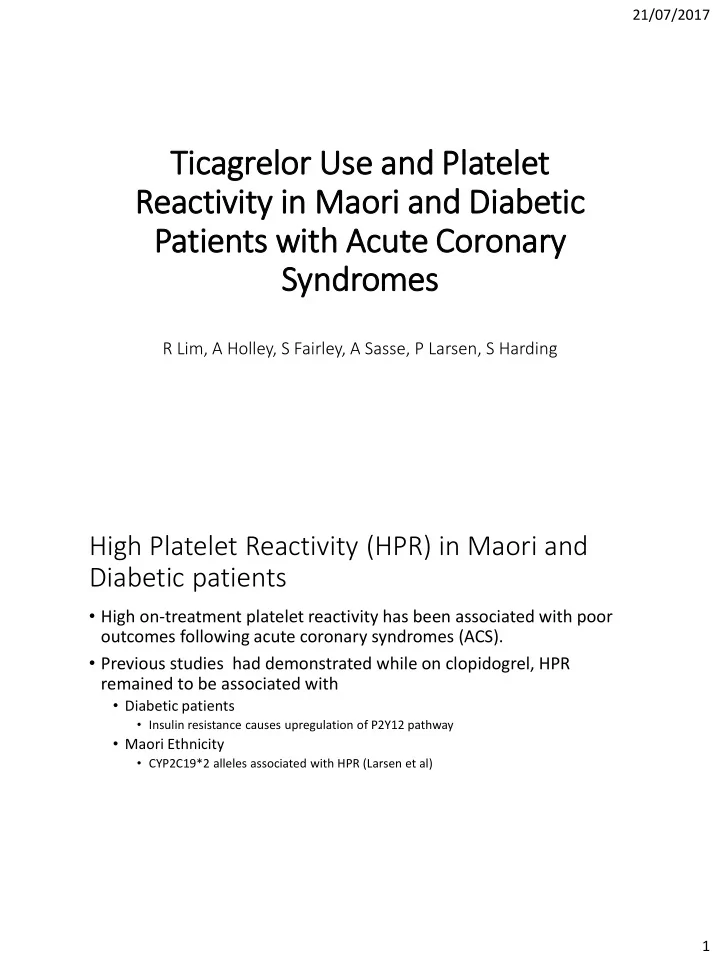

21/07/2017 Tic icagrelor Use se and Pla latelet Reactivity in in Maori and Dia iabetic Patients with ith Acute Coronary ry Syndromes R Lim, A Holley, S Fairley, A Sasse, P Larsen, S Harding High Platelet Reactivity (HPR) in Maori and Diabetic patients • High on-treatment platelet reactivity has been associated with poor outcomes following acute coronary syndromes (ACS). • Previous studies had demonstrated while on clopidogrel, HPR remained to be associated with • Diabetic patients • Insulin resistance causes upregulation of P2Y12 pathway • Maori Ethnicity • CYP2C19*2 alleles associated with HPR (Larsen et al) 1
21/07/2017 Ticagrelor for these high risk patients • More potent antiplatelets, ie ticagrelor / prasugrel is likely to be a better treatment choice in these patients. Larsen et al 2
21/07/2017 Objectives of study: 1. Establish frequency of ticagrelor use in Maori and Diabetic patients 2. Establish if Maori ethnicity or diabetes remained predictive of HPR on ticagrelor. Methods • Data prospectively gathered of 1224 ACS patients presenting to Wellington Regional Hospital from June 2012 to June 2016 • All patients had undergone platelet function testing with multiplate assay prior to undergoing coronary angiography. • HPR was defined as greater then 47 AU 3
21/07/2017 Patient Characteristics ACS population (1224) Ticagrelor Population Clopidogrel Population (311) (913) Age 63.5 (SD 10.8) 61.37 (SD 9.8) 64.2 (SD 11.1) BMI (kg/m2) 29.3 (SD 5.7) 29.2 (SD 9.8) 29.3 (SD 5.8) Other Cardiac Risk Factors HTN 747 (61%) 170 (54.7%) 577 (63.2%) Hyperlipiedemia 830 (67.8%) 201 (64.4%) 629 (68.9%) Smoker 286 (23.4%) 79 (25.4%) 207 (22.7%) Family Hx 432 (35.3%) 123 (39.5%) 309 (33.8%) Clinical Presentation STEMI 253 (20.6%) 37 (11.8%) 216 (23.6%) NSTE-ACS 971 (79.4%) 274 (88.2%) 697 (76.3%) Diabetic Patients were Less Likely to be Prescribed Ticagrelor 90 81 80 73 70 60 Percentage 50 Odds Ratio 0.64 CI 40 0.45-0.91, p= 0.01 27 30 19 20 10 0 Not Diabetic Diabetic Clopidogrel Ticagrelor 4
21/07/2017 Ticagrelor usage and Maori Ethnicity 80 75 74 70 60 Percentage 50 40 26 30 25 20 10 0 Non Maori Maori Clopidogrel Ticagrelor High on Treatment Platelet reactivity 40 35 35 30 Percentage HPR 25 20 16 15 10 5 0 All Patients Cloidpgrel Ticagrelor 5
21/07/2017 High on Treatment Platelet Reactivity 50 46 44 45 40 Percentage with HPR Overall Clopidogrel HPR Rate 35 30 25 20 15 Overall Ticagrelor HPR Rate 14 15 10 5 0 Diabetic Maori Clopidogrel Ticagrelor Uptake of Ticagrelor • Our study shows a low usage of ticagrelor in overall ACS patients (25%) • Usage of ticagrelor in diabetic subpopulation was significantly lower then the overall ACS population. • There is a trend of ticagrelor use in ‘healthier patients’ ? Unfamiliarity with drug causing it to be less used in patients with high bleeding risk ie more comorbidities 6
21/07/2017 Discussion on HPR • Our study indicates: • High platelet reactivity remains significant in diabetics and patients of Maori Ethnicity after clopidogrel loading • This may result in increased future cardiovascular events. • The risk of HPR in Diabetic and Maori population is attenuated by the loading of ticagrelor at presentation with ACS. • There is a clear benefit of ticagrelor over clopidogrel in terms of HPR • This may translate into reduction in MACE events in this populations. Conclusion • Ticagrelor prescribing is low in the diabetic population in our cohort. Reasons of this requires further investigation. • In diabetic and Maori patients on clopidogrel, High Platelet Reactivity persists compared to other ACS patients on clopidogrel. • Awareness of HPR and benefits of ticagrelor may increase prescribing of ticagrelor these population groups. 7
21/07/2017 • Thank you 8
Recommend
More recommend